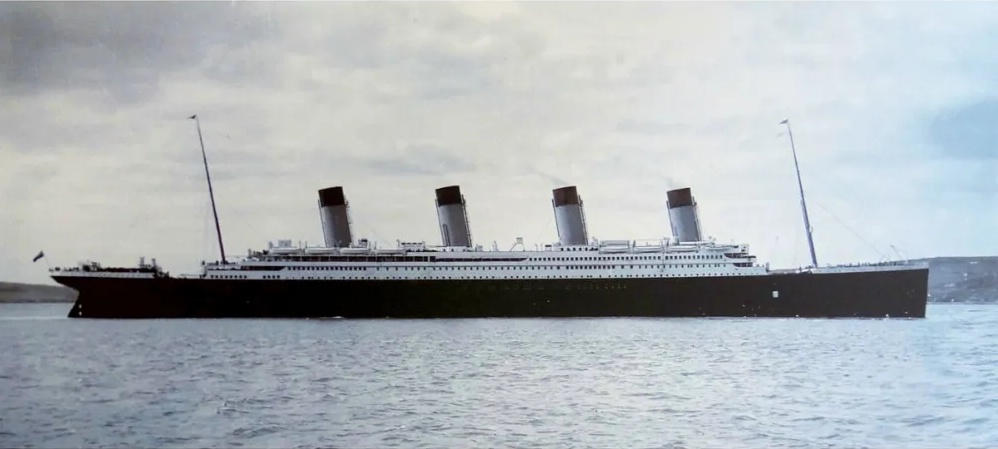 |
| Source: Wikimedia Commons |
The RMS Titanic, one of three Olympic-class ocean liners built at the turn of the century, was marketed as an "unsinkable ship" before her maiden voyage. It was built using the latest technology, including steel rivets that were more durable than their iron counterparts. People from all walks of life—from poor immigrants to the rich and famous elite—bought tickets for the luxury liner's maiden voyage. Some were on their way to America for a new life. Others returned home from work. Others are looking for a fun seaside vacation. On the evening of April 14, 1912, all these plans came to a screeching halt when the unsinkable ship Titanic hit an iceberg and sank in less than three hours. There is no information about these events beyond the stories of the survivors, but these photos can give an idea of what the doomed ship might have been like. Take a look at these rare photos of the Titanic and try not to shudder to think what it must have been like on that fateful night.
Let us know what you think in the comments, and don't forget to SHARE these amazing photos with other history buffs and ship enthusiasts.
She Was Called "Titanic" For A Reason.
 |
| Source: Wikimedia Commons |
The RMS Titanic was the world's largest passenger ship when it was unveiled in 1912. At 882 feet long, 175 feet high, and weighing 46,328 tonnes, there was simply nothing else like it. The sheer size of the ship added to its almost mythological aura and made the sinking of the ship even more shocking.
It Could Be Worse.
 |
| Source: Wikimedia Commons |
The sinking of the Titanic was one of the greatest tragedies in modern history; only 710 people out of 2224 survived. Although the loss of life was greatly mourned and passed down in history, the tragedy could have been much greater. But since the Titanic was well below capacity on her maiden voyage, her maximum under-capacity was actually 3,327.
The Third Class Was The First To Die.
 |
| Source: Wikimedia Commons |
Many of the ship's passengers were third-class families looking to start a new life in America. These passengers were at the bottom of the ship and were among the first to go under the water. The stairwell had gates that were locked to keep the third class separate from the others. As the attendants did not have time to open all the gates amid the chaos, many of these passengers were trapped below deck and drowned.
The Ticket Prices Were Incredibly High.
 |
| Source: eBay |
As a luxury cruise ship, the Titanic's fare was high. First-class tickets ranged from $30 to $4,350 ($775 to $112,000 today). Second-class tickets cost $12 to $60 ($300 to $1,500 today), and third-class tickets cost $8 to $40 ($200 to $1,100 today). Even accounting for inflation, these are expensive tickets.
The Disaster Was Foreseen.
 |
| Source: Wikimedia Commons |
Fourteen years before the maiden voyage of the Titanic, author Morgan Robertson wrote a novel, The Wreck of the Titan: Or, Futility, about the world's largest ship that met with disaster. In the fictional story, the ship was called the Titan. Its dimensions were almost identical to those of the Titanic, as was the speed with which they traveled after the disaster. In addition, both collided with an iceberg on the right side. Both also drowned in the exact same place in April, with as few lifeboats as the law allowed. Although people believed him to be clairvoyant, Robertson claimed that he only had a vast knowledge of ships and sailing.
RMS Stands For Something You Wouldn't Expect.
 |
| Source: Getty Images |
During the voyage of the Titanic, all British ships bore the letters RMS, which stood for Royal Mail Ship. The term dates back to the 1840s when the British government agreed to carry mail only on the fastest and most reliable ships. The RMS prefix became known as a mark of distinction and quality.
The Team Was Responsible For The Mistake.
 |
| Source: Getty Images |
There were 908 crew members on the Titanic. A higher percentage of crew members were killed than in any other group except men of second and third class. Many of them were lost when the boiler rooms flooded in the first collision; others died rescuing passengers below decks. All five postmen died trying to save the mail they were assigned to protect.
Many Men Knew They Would Not Succeed.
 |
| Source: Wikimedia Commons |
John Jacob Astor IV was the richest passenger on the ship. His net worth has been estimated at $85 million. (That's about $2 billion today.) He was traveling with his pregnant wife, whom he helped load into a lifeboat through a side window. He said to him, "The sea is calm. All is well with you. You are in good hands. See you later." Those were his last words to her. He died when the ship sank.
Many Others Almost Fell.
 |
| Source: Wikimedia Commons |
Many famous people bought tickets for the trip but did not actually travel. They included the founder of Hershey's Chocolate, pioneering inventor Guglielmo Marconi, J.P. Morgan and Milton S. Hershey, an American banking and steel magnate. It is safe to say that the future of the 20th century could have been very different if these men had been brought on board.
The Ship Ran On Coal Fuel.
 |
| Source: Getty Images |
The Titanic required more than 600 tonnes of coal a day to keep its enormous engines running, leaving Southampton with more than 6,000 tonnes of coal. This coal was shoveled into large boilers by three furnaces. Firefighters who were called in shoveled coal into the furnaces in very hot and dirty conditions. Many of these men were among the first to die when their workrooms were flooded and the watertight doors closed automatically to prevent the rest of the ship from being flooded.
The Titanic Had Four Stacks.
 |
| Source: Getty Images |
The Titanic had four large funnels, also known as stacks. The ship's engines directed the smoke through these funnels. Three of them filled the chimney, and one filled the vent. When the boiler rooms started taking on water, there was a huge fear that the cold sea water hitting the hot steam stored in the funnels would cause them to explode. To avoid this, firefighters and engineers had to quickly release as much steam as possible from the stacks.
Many Crew Members Were Not Sailors.
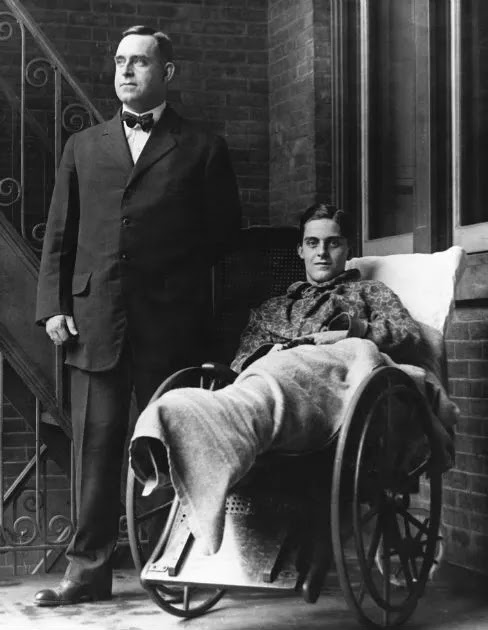 |
| Source: Getty Images |
Maids, waiters, and chambermaids were called Titanic stewards. Of the 421 companions on the ship, only 60 survived, and 48 of them were women. Pictured above is Steward Thomas Whiteley, whose leg was broken by falling debris while boarding the lifeboat. Another stewardess, Violet Jessop, was aboard Titanic's sister ship, RMS Olympic when it collided with a British warship a year earlier. She survived that, the Titanic disaster, and the sinking of their other sister ship, the Britannic, four years later. She became known as "Miss Unsinkable".
The Captain Didn't Make A Tough Call.
 |
| Source: Wikimedia Commons |
On the night of the sinking, the captain of the Titanic, Edward J. Smith, retired for the evening, leaving the executive officer, William McMaster Murdoch. When Murdoch was warned of the iceberg, he ordered the ship to turn around immediately and stop the engines. Unfortunately, it was too late. Due to the massive dimensions of the boat, it did not turn in time to avoid the collision, and the starboard side hit the iceberg.
The Shot Was Seconds Away.
 |
| Source: Wikipedia |
Observer Frederick Fleet (pictured) spotted the iceberg only about a minute before the Titanic hit it. In the time it took to get the message across, the officers on the bridge had only about 30 seconds to decide what to do, leaving them with more than a century of guesswork. Fleet survived that night but unfortunately suffered from depression for the rest of his life, probably due to the tragedy of the drowning. He committed suicide by hanging in January 1965.
The Captain Was One Of The Best.
 |
| Source: Wikimedia Commons |
Titanic's captain, Edward J. Smith, had a long and successful career with the White Star Line, having been transferred from Titanic's sister ship, RMS Olympic, specifically for that maiden voyage. His last words to the crew were, "Well, boys, do your best for the women and children, and take care of yourselves." Smith planned to retire after the trip.
Several Ice Warnings Were Issued By Other Ships.
 |
| Source: Getty Images |
The Titanic had been warned several times about floating sea ice in the days before the disaster. Several ships reported "field and pack ice" and relayed the reports to the Titanic. But as the radio transmitters dealt with the backlog of passenger messages from the previous day, only two of the six that were received made it to the bridge. Just nine minutes before the collision, the SS Californian announced that it had stopped at the ice rink for the night. Tragically, radio operator Jack Phillips interrupted them and announced that he was busy writing messages from passengers.
There Were No Binoculars In The Crow's Nest.
 |
| Source: Getty Images |
Because of the confusion in Southampton Harbour, there were no binoculars in the crow's nest. It didn't matter much, though, considering how dark the night was. Although the weather was clear, there was no moon, and the water was incredibly flat and calm, making it impossible to tell if the waves were crashing against the obstacles ahead. However, the crew member who spotted the iceberg, Frederick Fleet, later admitted to inquiries that if he had been given binoculars, "We might have seen it (the iceberg) a little earlier. Well, enough to get out of the way."
They Have Already Sold The Return Tickets.
 |
| Source: Wikimedia Commons |
Before Titanic's journey across the Atlantic began, she docked at two different landing spots: Cherbourg, France, and Queenstown, Ireland. She was to stop in Manhattan to allow first and second-class passengers to disembark, then proceed to Ellis Island to allow third-class passengers to clear immigration. The Titanic's return voyage was scheduled to leave New York on April 20, with several more throughout the year until December 28.
Record-Setting Sinking
 |
| Source: Wikipedia |
When the Titanic hit the iceberg, it took the entire ship 2 hours and 40 minutes to sink. In the past, ships with the same fate took nearly 12 hours to sink. If the Titanic had lasted that long, help would have arrived in time, as the Carpathian arrived around 4 a.m.
The Iceberg Remained Close To The Surface.
 |
| Source: Wikimedia Commons |
The day after the sinking of the Titanic, a steward on another ship took an ominous photo of a large iceberg. This photo, showing a clear black mark on the mountainside, was an eerie reminder of the events of the previous day.
The Youngest Traveler Became Famous.
 |
| Source: Wikimedia Commons |
Titanic's youngest surviving passenger, Elizabeth Gladys Millvina Dean, was only 9 months old when she boarded the ship with her mother, father, and older brother Bertram. He escaped with his mother and brother, but his father drowned. Her family was supposed to move to America, but after the death of her husband, Gladys' mother decided to move back to Southampton. Millvina was described as "the darling of the ship" all the way back to England.
No One Has Survived.
 |
| Source: Getty Images |
Millvina was the last survivor of the Titanic wreck when she died in 2009 at the age of 97. When he died, he was cremated. His ashes were scattered on the harbor in Southampton, where he and his family boarded the Titanic as children.
Titanic Dining.
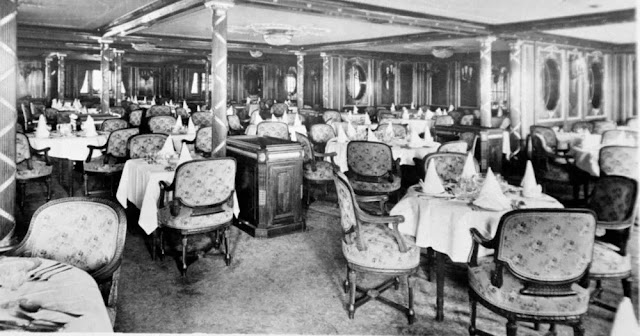 |
| Source: Getty Images |
The a la carte restaurant on deck B was for first-class passengers only. Between this, the ship's second cafe, and the regular dining room, first-class passengers had many interesting dining options while on board. À la Carte was owned by Italian businessman Luigi Gatti, who died on the Titanic. Of the restaurant's 66-member staff, only one male clerk and two female cashiers survived.
She Became A Model After The Ritz Hotel.
 |
| Source: Wikimedia Commons |
Rumour has it that the luxurious interior of the Titanic was inspired by the world-famous Ritz Hotel in London. It had a grand staircase, racquetball courts, a swimming pool, and a state-of-the-art gym. There were also several restrooms, reading rooms, and smoking rooms. It was designed to be the absolute pinnacle of luxury.
The Orchestra Played Happy Tunes.
 |
| Source: Wikimedia Commons |
As shown in the film, an orchestra played during the sinking. They tried to comfort the passengers. For the most part, they didn't play sad, gloomy music; that would be considered a bad omen and would only increase the panic. Instead, they played ragtime and happy dance music. Only at the end, when the verdict was certain, did they start playing hymns at the request of passengers in trouble. The band's last song is the talk of the town to this day.
There Weren't Enough Rafts For Everyone.
 |
| Source: Wikimedia Commons |
If life rafts were taken more seriously, many lives could have been saved. In the beginning, there were only 20 ferries, sufficient for only about a third of the capacity of the ship. She had room for 64 people, but the White Star Line wanted an unobstructed view of the sea, and ferries at the time were only designed to carry passengers from one ship to a lifeboat. It was incomprehensible that the ship sank in less than three hours. The crew was also not properly trained on the boats. They only completed one drill, and even then, most of the team did not know their intended position. Many said that even if all 64 boats were on board, it is doubtful that all would have successfully launched due to the lack of training.
Many Were Never Found.
 |
| Source: Getty Images |
Eight ships searched for and collected bodies in the Atlantic. Many bodies were unidentified and buried at sea. Some were not found until a month later, such as the bodies found by the RMS Oceanic floating in the collapsible boat A. Only a third of the bodies were found.
The Ship Did Not Survive.
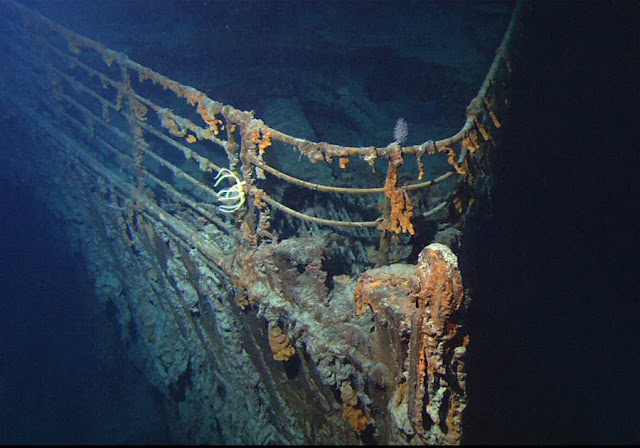 |
| Source: Wikimedia Commons |
Experts believe that it only took the Titanic 15 minutes to reach its final resting place on the seabed after sinking below the surface of the water. It sank so fast that it dug large holes in the seabed where it landed. The force of the collision caused the decks to collapse on each other, which further flattened the wreckage on the seabed.
It Took 73years To Find The Wreck.
 |
| Source: Wikimedia Commons |
Because the wreck of the Titanic was so deep in the ocean, it took a long time to find it. This difficulty was compounded by the fact that its location was given inaccurate coordinates before it sank, leading scientists, historians, and divers to search for it for decades. It was finally discovered in 1985 to great acclaim by Robert Ballard.
The Titanic Ticket Is Still Expensive.
 |
| Source: Getty Images |
Many people don't know that you can visit the Titanic at the bottom of the sea. It breaks pretty fast now, so it won't stay there forever, and you can only go if you have deep enough pockets. A ticket to a private party at the wreck costs $59,000 per person. Anyone rich enough can take on a private company called Deep Ocean Expeditions.
Maybe There Would Be A Titanic Ii.
 |
| Source: Wikimedia Commons |
An Australian millionaire named Clive Palmer planned to build a replica called Titanic II. It was originally scheduled for 2016, then pushed back to 2018. As of October 2018, the project has a planned start date of 2022. It's worth noting that Palmer is famous for outlandish plans that he never sees through, such as a Jurassic Park replica at his golf resort and a commercial by The Zeppelin Company. It's just as well if it doesn't come to fruition, as many saw the Titanic II plan as crude and insensitive.
George Washington Vanderbilt Ii Altered His Plans At The Last Minute.
 |
| Source: Wikimedia Commons |
George Washington Vanderbilt II, inheriting the Vanderbilt fortune, was the esteemed grandson of Cornelius Vanderbilt. He was supposed to be on the Titanic, but his brother-in-law told him about potential problems traveling on the ship on its maiden voyage, and a few days before it left, he changed his mind. However, he sent his luggage and one of his servants on the Titanic. Servant-second-class men (the group with the highest death rate on board) died.
Theodore Dreiser Almost Faced Disaster.
 |
| Source: Wikimedia Commons |
The famous author Theodore Dreiser also changed his plans and did not board the ship but followed the advice of the publisher to choose a cheaper one. After the sinking of the Titanic, he wrote: "To think of such a great ship as the Titanic, new and shiny, sinking into the endless depths of water And those two thousand passengers left their places like rats to float helplessly through miles of water, praying and crying!"
Henry Clay Frick Was Saved From A Sprained Ankle.
 |
| Source: Wikimedia Commons |
American steel magnate Henry Clay Frick was going on the Titanic. However, his wife sprained her ankle days before the trip, and they decided it was best for him to stay back and rest. The happiest sprained ankle ever.
Guglielmo Marconi's Papers Kept Him Alive.
 |
| Source: Wikimedia Commons |
Guglielmo Marconi, Nobel laureate and famous inventor of the telegraph, was offered free passage on the Titanic but chose to travel on the Lusitania instead. His daughter later said that it was because of paperwork and that he preferred the ship's telegraph to the Titanic.
Alcohol-induced Survival.
 |
| Source: Twitter/@TitanicUSA |
Titanic's chief baker, Charles Joughin, survived the sinking by holding on to the ship and "riding" it down as it sank, then reportedly swam in the icy waters of the Atlantic for nearly two hours before being picked up by a lifeboat. According to Joughin, he was able to stay calm and stay afloat thanks to the large amount of whisky he drank before abandoning the ship. Liam Tuohy played him in James Cameron's film.
Indeed, Economic Inequality.
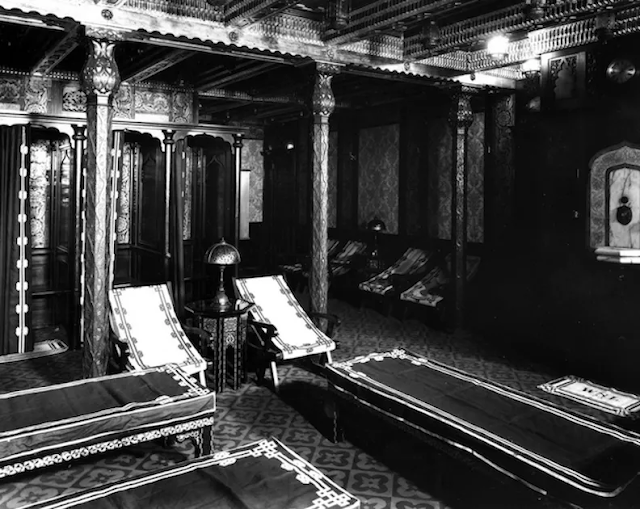 |
| Source: Twitter/@romandiseat2 |
One of the most luxurious areas of the Titanic was its large Turkish bath. The area with steam rooms and massage tables was only available to first-class passengers. In contrast, 700 third-class passengers had to share two bathrooms.
The Engineers Made The Ultimate Sacrifice.
 |
| Source: Twitter/@HistoricalSoton |
All of Titanic's engineers died in the sinking when they remained below deck, holding power so that others could escape as long as possible rather than trying to abandon the ship. In 1914, a monument to the heroic Titanic engineers (pictured) was built in Southampton.
A tragic Title
 |
| Source: Twitter/@drlindseyfitz |
The first newspaper reports of the Titanic disaster falsely claimed that no lives were lost. Unfortunately, it took a few days for the truth to come out.
Haunted Honeymoon.
 |
| Source: Twitter/@LipontPlace |
13 couples celebrated their honeymoon on the Titanic's maiden voyage, including the aforementioned John Jacob and Madeleine Astor (pictured). Of these couples, three were killed by total drowning; four saw half of the couple alive; one died; and six couples survived.
Mysterious Canceled Lifeboat Rake.
 |
| Source: Wikimedia Commons |
The lifeboat exercise was supposed to take place on the morning of April 14, the day the Titanic hit the iceberg. Captain Smith interrupted the exercise for unknown reasons. Although it is unlikely that many people would have been saved if the exercise had taken place, its cancellation still seems like an ominous coincidence.
Meet The 13 Hottest Female Billionaires That Set the World on Fire!
